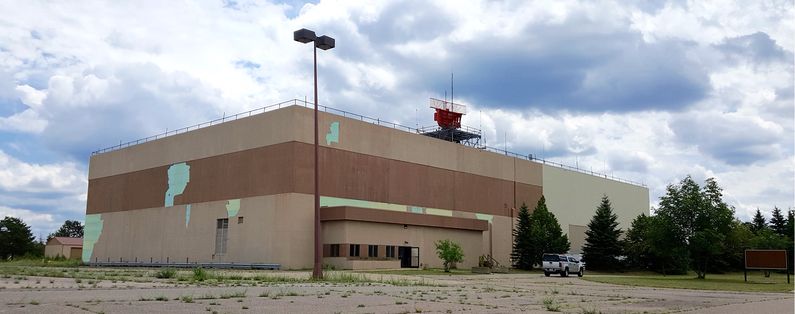Antigo Air Force Station
|
Antigo Air Force Station (1952-1977) - A Cold War Air Force Radar Station first established in 1952 in Langlade County, Wisconsin. Named Antigo Air Force Station after the nearby town. Initially assigned a Permanent ID of P-19, later a Sage ID of Z-19. Abandoned by the Air Force in 1977. HistoryEstablished in 1952 and became operational in June 1952 as Antigo Air Force Station manned by the 676th AC&W Squadron. The station initially had both a Ground-Control Intercept (GCI) and early warning mission. The early warning mission involved tracking and identifying all aircraft entering their airspace while the GCI mission involved guiding Air Force interceptors to any identified enemy aircraft. Controllers at the station vectored fighter aircraft at the correct course and speed to intercept enemy aircraft using voice commands via ground-to-air radio. Initial equipment included the FPS-3 search radar and an FPS-4 height-finder radar. By 1958 the site was operating a FPS-20 and a FPS-6A. In 1959 a second FPS-6A was added to establish the normal pre SAGE System configuration of a long range search radar with two height-finders. SAGE System TransitionThe transition of the manual GCI system to the automated SAGE system began with the installation of the FST-2 coordinate data transmitter and search radar upgrades. The FST-2 equipment digitized the radar returns and transmitted the digital returns to the SAGE direction center. Under the SAGE System, interceptor aircraft were directed to their targets by the direction center computers and controllers, greatly reducing the need for local controllers and equipment at every radar station. The FST-2 was a very large digital system using vacuum tube technology. Over 6900 vacuum tubes were used in each FST-2 requiring 21 air-conditioned cabinets, 40 tons of air conditioning, 43.5 kva of prime power, and usually a large new addition to the operations building. The FST-2B modification added two more cabinets but with newer solid-state (transistor) technology to process coded responses from aircraft transponders. SAGE System Operation
The site began operation as a SAGE site in 1960 initially feeding the K.I. Sawyer SAGE Direction Center DC-14. The search radar was upgraded to an FPS-35 in 1962 and later a FPS-90 height-finder radar was added. By February 1973 the Air Force had completed an 18 month replacement program, swapping the aging vacuum tube FST-2s with integrated circuit FYQ-47s and FYQ-49s. Antigo received a replacement FYQ-47 and the FST-2 was removed. ClosureThe Air Force publicly announced the closure of Antigo Air Force Station on 9 Mar 1977. At the time of the announcement the station had 79 military personnel assigned and 28 civilian employees. Antigo AFS and the 676th Radar Squadron were deactivated on 30 Jun 1977. Gap FillersAntigo AFS was responsible for the maintenance of three remote unattended gap-filler radar sites. The unattended gap filler sites were placed in locations where the main search radar lacked coverage. These sites were equipped with short range FPS-14 or FPS-18 search radars and FST-1 Coordinate Data transmitters that sent digitized radar target data to a SAGE direction center and to the main radar site. Both the radar set and the FST-1 were dual channel to increase site up time. Maintenance teams were dispatched for regularly scheduled maintenance or when fault indicators on the FSW-1 remote monitoring equipment suggested the site had problems. The FSW-1 also allowed remote operation of specific functions such as channel changes for the radar and for the FST-1, it also allowed remote operation of the diesel generators at the gap filler site. The Antigo AFS gap-filler radars were located at Norway, MI, Two Creeks, MI and Brooks, WI. Three other gap-fillers were planned but not constructed.
Physical PlantThe physical plant of the site was divided into the main site, a cantonment area, a housing area and a radio site. The main site housed the operations buildings, the radar towers, and the backup generators. The cantonment area housed the enlisted barracks, the bachelor officer's quarters, the orderly room, the dining hall, the motor pool and other support buildings. Apart from the main site was a small housing area for critical married personnel. A separate radio site housed the radio equipment for directing aircraft intercepts. Like most early radar stations, Antigo originally had a radio transmitter site and a separate radio receiver site used by local controllers for voice direction of fighter interceptors to their targets. With the SAGE System, the SAGE Direction centers had the primary task of directing intercepts and the local radio sites were reconfigured, usually into a single site that was known as the Ground to Air Transmitter Receiver (GATR) site. The GATR site communicated with the interceptors from either the local site or the SAGE direction center via voice commands and/or a digital data link.
Current StatusAbandoned in Antigo, Langlade County, Wisconsin.
See Also:
Sources:
Visited: No
|